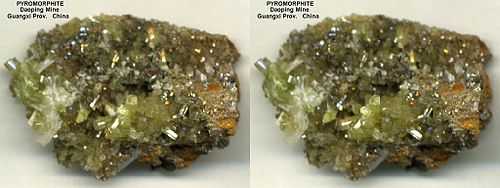| Pyromorphite |
|---|

|
| General |
|---|
| Category |
Phosphate mineral
Apatite group |
|---|
Formula
(repeating unit) |
Pb5(PO4)3Cl |
|---|
| Strunz classification |
08.BN.05 |
|---|
| Identification |
|---|
| Color |
Dark grass-green, green, yellow, yellow-orange, reddish orange, yellow-brown, brown, tan, grayish, may be colorless |
|---|
| Crystal habit |
Prismatic to acicular crysals, globular to reniform |
|---|
| Crystal system |
Hexagonal - Dipyramidal H-M Symbol (6/m) Space Group: P 63/m |
|---|
| Twinning |
Rarely on {1122} |
|---|
| Cleavage |
Imperfect- [1011] |
|---|
| Fracture |
Uneven to sub-conchoidal |
|---|
| Tenacity |
Brittle |
|---|
| Mohs scale hardness |
3.5-4 |
|---|
| Luster |
Resinous to subadamantine |
|---|
| Streak |
White |
|---|
| Diaphaneity |
Transparent to translucent |
|---|
| Specific gravity |
7.04 measured, 7.14 calculated |
|---|
| Optical properties |
Uniaxial (-) May be anomalously biaxial - |
|---|
| Refractive index |
nω = 2.058 nε = 2.048 |
|---|
| Birefringence |
δ = 0.010 |
|---|
| Pleochroism |
Weak |
|---|
| Ultraviolet fluorescence |
May fluoresce yellow to orange under LW and SW UV |
|---|
| Other characteristics |
Piezoelectric if biaxial |
|---|
| References |
[1][2][3] |
|---|
Pyromorphite is a mineral species composed of lead chlorophosphate: Pb5(PO4)3Cl, sometimes occurring in sufficient abundance to be mined as an ore of lead. Crystals are common, and have the form of a hexagonal prism terminated by the basal planes, sometimes combined with narrow faces of a hexagonal pyramid. Crystals with a barrel-like curvature are not uncommon. Globular and reniform masses are also found. It is part of a series with two other minerals: mimetite (Pb5(AsO4)3Cl) and vanadinite (Pb5(VO4)3Cl), the resemblance in external characters is so close that, as a rule, it is only possible to distinguish between them by chemical tests.
They were formerly confused under the names green lead ore and brown lead ore (German: Grünbleierz and Braunbleierz). The phosphate was first distinguished chemically by M. H. Klaproth in 1784, and it was named pyromorphite by J. F. L. Hausmann in 1813. The name is derived from the Greek for pyr (fire) and morfe (form) due to its crystallization behavior after being melted.[2]
Properties and isomorphism
The color of the mineral is usually some bright shade of green, yellow or brown, and the luster is resinous. The hardness is 3.5 to 4, and the specific gravity 6.5 - 7.1. Owing to isomorphous replacement of the phosphorus by arsenic there may be a gradual passage from pyromorphite to mimetite. Varieties containing calcium isomorphously replacing lead are lower in density (specific gravity 5.9 - 6.5) and usually lighter in color; they bear the names polysphaerite (because of the globular form), miesite from Mies in Bohemia, nussierite from Nuizière, Chénelette, near Beaujeu, Rhône, France, and cherokine from Cherokee County in Georgia.
|
|
Parallel view ( ) ) |
|---|
|
|
Cross-eye view ( ) ) |
|---|
|
|
| Small specimen of Pyromorphite from China |
See also
References

 This article incorporates text from a publication now in the public domain: Chisholm, Hugh, ed. (1911). Encyclopædia Britannica (11th ed.). Cambridge University Press
This article incorporates text from a publication now in the public domain: Chisholm, Hugh, ed. (1911). Encyclopædia Britannica (11th ed.). Cambridge University Press
